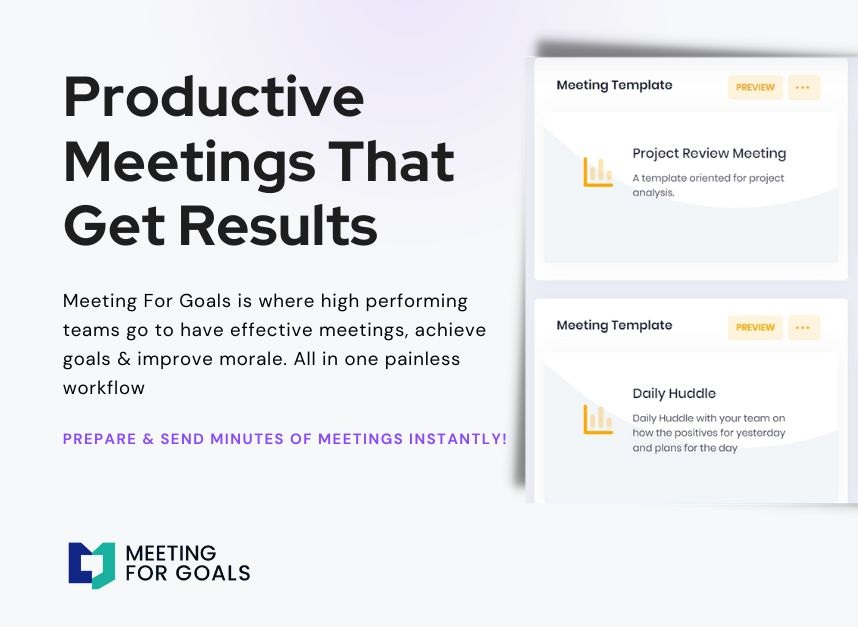How to Take Meeting Minutes: A Guide for High-Performing Teams
Excerpt:
Effective meetings are the foundation of successful teams. But without proper documentation, important discussions, decisions, and action items can slip through the cracks. This is where meeting minutes come in. Well-structured meeting minutes improve accountability, streamline follow-ups, and keep meetings aligned with company goals.
In this guide, we’ll walk you through the best practices for taking meeting minutes—from preparation to distribution. Plus, discover how Meeting For Goals can simplify the process, making your meetings more organized and productive.
2 Minute Video
Watch a 2 minute demo of our meeting management software in action
I. Introduction
A. Why Meeting Minutes Matter
Meetings are essential for collaboration, decision-making, and problem-solving. But without proper documentation, key takeaways can be lost, leading to confusion and inefficiency. Meeting minutes capture important discussions and decisions, ensuring that every meeting has a lasting impact.
1. Keep Track of Key Discussions and Decisions
Meeting minutes serve as an official record of what was discussed and agreed upon. This helps teams review past conversations, track progress, and ensure that important topics don’t get forgotten.
2. Improve Accountability and Follow-Up
Without clear documentation, action items can be overlooked. Meeting minutes specify who is responsible for what, making it easier to follow through on tasks and commitments.
B. How Meeting For Goals Helps
Meeting For Goals is a meeting management platform designed to help teams run more effective meetings. It aligns meetings with company objectives, enhances accountability, and simplifies documentation.
1. Well-Structured Minutes Lead to Productive Meetings
Organized meeting minutes reduce misunderstandings and keep teams aligned with their goals.
2. Streamline the Process with Meeting For Goals
With Meeting For Goals, teams can easily capture, organize, and share meeting minutes, ensuring that every meeting is action-driven and results-focused.
Adding an Agenda
How to add an agenda instantly on Meeting For Goals
II. Preparing for the Meeting
A. Understand the Agenda
Good meeting minutes start with preparation. Before the meeting, review the agenda to understand the key topics.
1. Review Topics in Advance
Knowing what will be discussed helps you anticipate important points and take better notes.
2. Identify Key Participants and Their Roles
Understanding who will be in the meeting and their roles helps you track contributions and assign action items effectively.
B. Set Up Your Tools
The right tools can make a big difference in how efficiently you take meeting minutes.
1. Choose the Best Note-Taking Method
- Digital vs. Handwritten Notes: Digital tools offer easy editing, searchability, and integration with other software.
- Meeting For Goals Integration: Our platform makes it simple to capture, organize, and distribute meeting minutes.
2. Use a Template for Consistency
A standardized template ensures that all key details are documented in a structured way.
III. Key Components of Effective Meeting Minutes
A. Essential Information to Include
Meeting minutes should be clear, concise, and well-structured.
1. Basic Meeting Details
Include the meeting date, time, location, and participants.
2. Agenda Items Covered
Listing agenda topics keeps the minutes organized and ensures nothing is missed.
B. Documenting Discussions
Accurate yet concise documentation is key to effective meeting minutes.
1. Summarize Key Points and Decisions
Instead of transcribing everything, focus on summarizing key takeaways, decisions, and challenges.
2. List Action Items and Assign Responsibilities
Clearly outline tasks, deadlines, and who is responsible to ensure follow-through.
IV. Best Practices for Taking Meeting Minutes
A. Active Listening and Note-Taking Tips
Good meeting minutes require active engagement and efficient note-taking techniques.
1. Stay Engaged While Taking Notes
Actively listening helps you capture the most important points without missing details.
2. Use Abbreviations and Symbols
A shorthand system helps you take notes quickly and efficiently.
B. Choosing the Right Note-Taking Style
Different meetings call for different note-taking styles.
1. Narrative vs. Bullet Points
- Narrative Style: Provides a detailed account of discussions, useful for formal meetings.
- Bullet Points: Offers a structured, easy-to-review format.
2. Pick the Best Method for Your Team
Consider your team’s preferences and the meeting’s complexity when choosing a style.
V. Finalizing and Sharing Meeting Minutes
A. Review and Edit for Clarity
Before distributing meeting minutes, review them for accuracy and clarity.
1. Proofread for Errors
Ensure the minutes are free from mistakes and clearly summarize discussions.
2. Provide Context for Absent Stakeholders
Adding context helps those who weren’t present understand key decisions.
B. Distribute Efficiently
Timely distribution ensures action items are addressed promptly.
1. Send Minutes Quickly
Share meeting minutes as soon as possible to keep momentum going.
2. Use Meeting For Goals for Seamless Sharing
Meeting For Goals makes it easy to distribute minutes, collect feedback, and track progress.
VI. Additional Tips for Taking Better Meeting Minutes
1. Use a Consistent Format
A structured format makes it easier for team members to review past meetings.
2. Highlight Key Decisions and Next Steps
Make action items stand out so they don’t get overlooked.
3. Leverage Technology
Digital tools like Meeting For Goals simplify the process and improve efficiency.
For further insights on meeting management, check out this Harvard Business Review guide on running effective meetings.
VII. Conclusion
A. Why Meeting Minutes Are Essential
Meeting minutes ensure that meetings are productive, action-oriented, and aligned with company goals.
1. Keep Teams Focused and Accountable
Well-documented minutes help teams stay on track and follow through on commitments.
B. Try Meeting For Goals Today
Meeting For Goals makes it easy to take, organize, and share meeting minutes, improving team efficiency.
1. Save Time and Improve Productivity
Our platform helps teams streamline meetings and drive better outcomes.
2. Explore More Resources
Learn how to optimize your meetings with this Forbes article on meeting productivity.
By following these best practices and leveraging Meeting For Goals, your team can ensure that every meeting is productive, goal-oriented, and results-driven. Start optimizing your meetings today!




